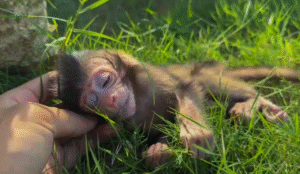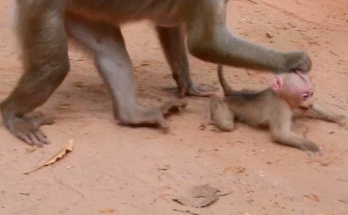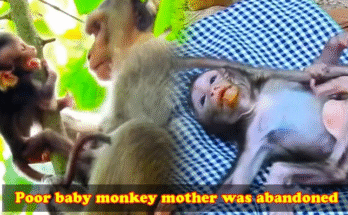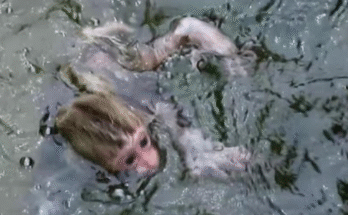In the dense canopy of a tropical forest, a tiny baby monkey finds itself struggling in the waters of a slow-moving river. Its small arms flail desperately, trying to cling to anything that might offer support. For a moment, the world seems cruelly indifferent, because the mother, who would normally swoop in to rescue her offspring, is just out of reach, navigating the treetops and unaware of the danger below.

The scene is both heart-wrenching and eye-opening, highlighting a raw aspect of nature that is rarely seen up close. Young animals, even those in seemingly safe habitats, are vulnerable. Life in the wild can be unforgiving, and moments like these remind us of the delicate balance between survival and danger. The baby monkey’s struggle is instinctive. Its tiny body is built for climbing and jumping, but water presents an entirely different challenge. The panic in its eyes reflects not only fear but a natural will to survive, a universal emotion shared across species.
Watching this small creature fight against the current evokes empathy. It also provides an important lesson about the independence young animals must develop to survive. In many species, mothers cannot always intervene immediately. They must continue foraging or protecting the wider family, leaving infants to navigate minor dangers on their own. Though it seems harsh, this process is essential. It teaches resilience and adaptability, skills that will later prove crucial for the baby monkey as it grows into adulthood.
This particular situation also opens a window into the intricacies of animal behavior. Observers might wonder why the mother isn’t nearby. In forest environments, distance between mother and infant is common. Mothers must balance feeding, resting, and keeping watch over multiple young ones. At times, this separation can place infants in risky circumstances, but it is part of a larger survival strategy. The mother’s absence does not mean negligence; rather, it reflects the challenging choices that animals must make every day.
Meanwhile, the baby monkey’s fight is a testament to determination. Even without immediate help, it uses its natural reflexes to stay afloat. Small movements, like paddling with its tiny limbs and holding its breath at intervals, help it maintain a fragile grip on life. While humans might feel a strong urge to intervene, this moment in nature is also a reminder that wild animals often face situations without external assistance. Their ability to persevere shapes their development and survival skills.
The water itself, though calm in appearance, poses serious threats. Currents, submerged rocks, and slippery banks all create obstacles. For a creature so small, a seemingly gentle river becomes a test of strength and instinct. Observing such moments encourages a deeper respect for wildlife. It reminds us that life in the wild is not staged or controlled; every action carries real consequences, and every day brings new challenges.
As the minutes pass, the baby monkey continues to struggle, gradually learning to navigate its environment more effectively. These early encounters with danger are formative, shaping its reflexes and judgment. While it might be hard to witness from a human perspective, such experiences are crucial to the development of independence and resilience. In the end, survival is not guaranteed, but every attempt to overcome adversity adds to the young animal’s chances of thriving in the future.
Moments like these teach us about both vulnerability and strength. They serve as reminders of the unpredictable nature of life in the wild, where every creature must rely on instinct and courage to face challenges. The image of the baby monkey in the water, alone yet fighting, leaves a lasting impression, showing that even the smallest beings possess an extraordinary will to survive.


